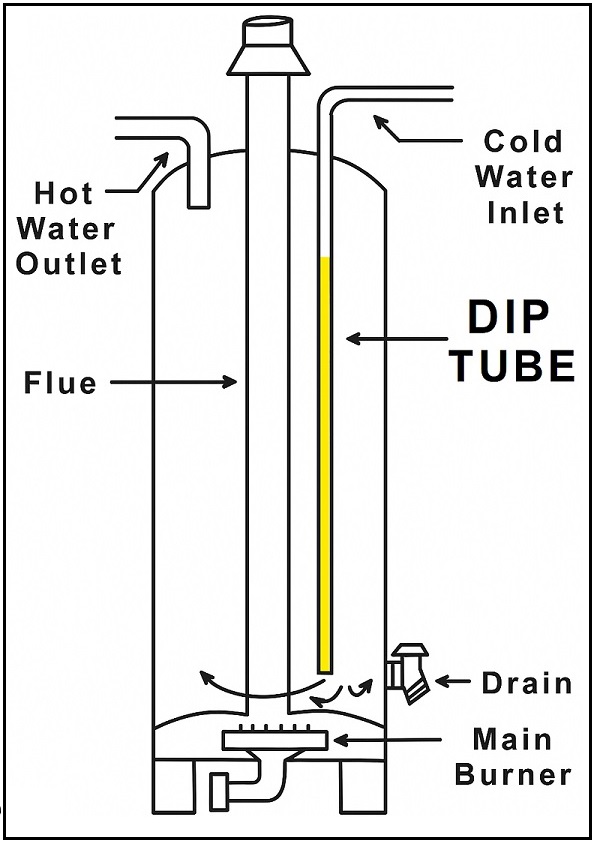Your water heater works hard behind the scenes to deliver hot water when you need it. However, when something goes wrong, even a minor component like the dip tube can disrupt the entire system. A broken dip tube in water heater can cause issues like inconsistent water temperature and reduced hot water supply.
Recognizing the symptoms early and knowing how to fix or replace this small yet vital part can save you from more significant problems down the line. In this guide, we’ll explain the role of the dip tube, signs it might be broken, and what you can do to repair or replace it effectively.
What is a Water Heater Dip Tube?
The dip tube is a long plastic or metal tube attached to the cold water inlet at the top of the tank. Its purpose is to carry incoming cold water to the bottom of the tank, where it can be properly heated.
Without a functioning dip tube, the cold water would remain near the top, mixing with the already heated water and reducing the overall water temperature. This small component is essential to ensure that the heating element or gas burner can work efficiently by keeping the cold water away from the hot water outlet.
In essence, the dip tube in a water heater directs the water flow in a way that maintains proper stratification within the tank for consistent hot water delivery.
Why Does the Dip Tube Matter?
Though small and inexpensive, the dip tube plays a crucial role in the overall performance of your water heater. It ensures that cold water is delivered to the bottom of the tank, where it can be efficiently heated and rise to the top to be delivered as hot water.
When the dip tube is broken, shortened, or missing, cold water mixes prematurely with the heated water at the top of the tank. This results in lukewarm showers, increased energy consumption, and a strain on your water heater. The entire heating process becomes inefficient, causing frustration and higher utility bills due to the system overworking itself to maintain hot water.
4 Common Symptoms of Broken Dip Tube in Water Heater
Here are the common broken dip tube symptoms are:
- Sudden or gradual loss of hot water
- Inconsistent water temperatures
- Presence of small white plastic particles
- Sediment and debris in the tank
Let’s explore each symptom of a broken water heater dip tube.
- Sudden or gradual loss of hot water: One of the most noticeable signs of a broken dip tube is that your water heater runs out of hot water more quickly than usual, or your shower turns cold midway.
- Inconsistent water temperatures: You may experience fluctuating temperatures, especially when using hot water from multiple taps at the same time.
- Presence of small white plastic particles: These fragments, often found in faucet aerators or showerheads, are usually pieces of a deteriorating dip tube.
- Sediment and debris in the tank: If your water heater is relatively new or hasn’t been flushed recently, broken dip tube pieces and sediment can collect at the bottom of the tank, affecting heating efficiency and reducing water pressure.
7 Causes of a Dip Tube Failure
Dip tube failure can occur due to several factors related to material quality, water chemistry, and heater age. Below are the main causes:
- Age and Material Degradation: Over time, plastic dip tubes degrade naturally from years of use and constant exposure to hot water.
- High Water Temperatures: Excessive heat within the tank can weaken plastic dip tubes, making them more prone to cracking or disintegration.
- Hard Water: Water with high mineral content accelerates the deterioration of the plastic, causing the tube to become brittle and break.
- Manufacturing Defects: Some dip tubes may fail early due to poor manufacturing quality or defects in the plastic used.
- Aggressive Water Chemistry: Acidic or chemically unbalanced water can corrode internal components, including plastic dip tubes.
- Anode Rod Failure: If the anode rod is no longer protecting the tank from corrosion, acidic conditions may form, contributing to dip tube damage.
- Internal Corrosion: General rust or corrosion inside the tank can physically damage the dip tube, especially in older systems.
How to Fix a Water Heater’s Broken Dip Tube?
Fixing a broken dip tube in water heater typically involves replacing it altogether. First, turn off the power or gas supply to the water heater and shut off the cold water inlet. Drain some water from the tank to minimize pressure and avoid spills.
Next, disconnect the cold water inlet pipe and remove the existing dip tube from the inlet fitting. If it’s broken, you may need to fish out the remaining pieces from inside the tank.
Once the tank is clear, install a new dip tube by sliding it into the cold water inlet and reconnecting the plumbing. Turn the water supply back on, bleed air from the system by opening a hot water faucet, and restore power to the heater. If done correctly, this simple water heater repair can restore normal hot water performance.
Can a Broken Dip Tube Be Prevented?
Preventing dip tube failure largely comes down to regular maintenance and monitoring. Flushing your water heater annually helps remove sediment and detect early signs of degradation. Using a water softener can also help reduce mineral buildup that leads to faster wear. Replacing the anode rod every few years can extend the life of internal components, including the dip tube, by reducing corrosion.
Choosing a high-quality replacement dip tube, ideally one made from cross-linked polyethylene (PEX), can help prevent future failures. Regular inspections by a professional plumber can also catch developing issues before they turn into expensive water heater repairs in Dallas, TX.
Conclusion: Fix Your Dip Tube and Restore Reliable Hot Water
A broken dip tube may seem like a minor issue, but it can greatly affect the performance of your water heater and your household’s comfort. By recognizing the symptoms early—such as lukewarm water, reduced hot water capacity, or visible plastic debris—you can address the problem quickly and efficiently.
Replacing a damaged dip tube is a straightforward process that can restore your system’s efficiency and provide consistent hot water once again. Preventive water heater maintenance in Dallas, TX, goes a long way in extending the life of your water heater and all its components. Don’t overlook this critical part of your system, and take action when symptoms first appear.
Are you noticing signs of lukewarm water or plastic debris in your taps? Schedule a water heater inspection from us at NTX Plumbing, a trusted water heater company in Dallas, TX.
FAQs On Broken Dip Tube In Water Heater
1. Can I run my water heater without a dip tube?
Technically, a water heater can operate without a dip tube, but its performance will be significantly impaired. Cold water will mix with hot water at the top of the tank, resulting in uneven heating and drastically reduced hot water supply. It’s not recommended to operate a heater without a functional dip tube.
2. How to check a dip tube in a water heater?
To check a dip tube, first shut off the water and power to your heater. Remove the cold water inlet and pull out the dip tube. Inspect it for length, cracks, or deterioration. If it’s broken or brittle, it should be replaced. Also, look inside the tank for floating plastic pieces, a sign of a deteriorating dip tube.
3. How to replace a water heater dip tube?
Start by turning off the heater and water supply. Drain a few gallons from the tank, remove the cold water inlet, and pull out the existing dip tube. Insert the new dip tube, ensuring it reaches the bottom of the tank, and reconnect all components. Restore water and power after checking for leaks.
4. How much does it cost to replace a dip tube?
Replacing a dip tube is relatively inexpensive. DIY replacement costs between $10 and $30 for the part, while professional water heater service in Dallas, TX, may range from $100 to $200, including labor. The total cost depends on the complexity of the setup and whether additional flushing or repairs are needed.
5. How long does a water heater dip tube last?
A dip tube typically lasts between 10 and 15 years, depending on water quality and usage. Hard water and lack of maintenance can shorten its lifespan, while regular flushing and a functioning anode rod can help it last longer. High-quality replacement tubes may offer improved durability over older models.






